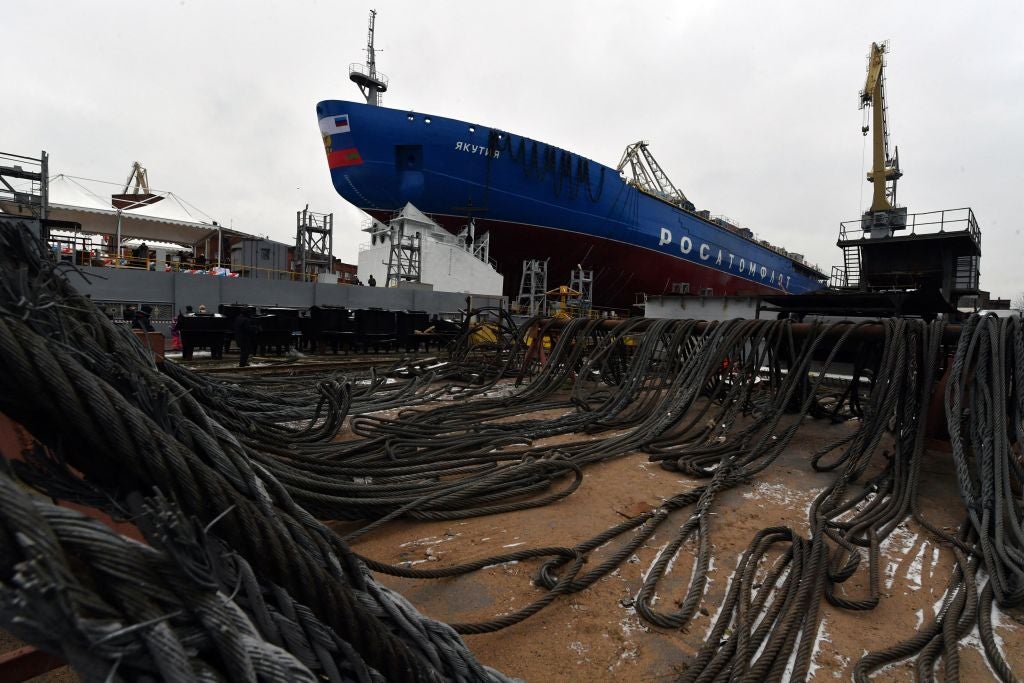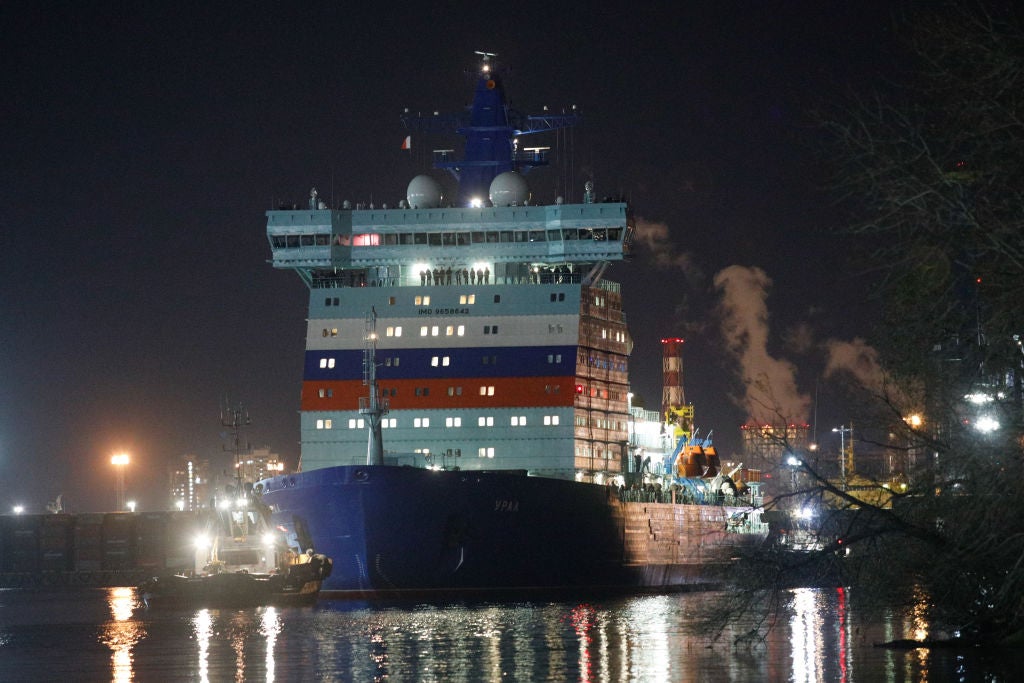
Russia is home to the only nuclear icebreaker fleet in the world, built to meet maritime transportation requirements through modern nuclear technology. The country’s aim of establishing an Arctic shipping route would open up its north coast to new projects, at a cost beyond money.
“The Russian shipbuilding industry has been growing for the past few years,” says Alexey Rakhmanov, president of Russia’s United Shipbuilding Corporation.
“This has especially happened in specific market segments, such as research vessels and nuclear-powered icebreakers, and niches such as the ice-resistant, self-propelled research platform North Pole.”
According to the Russian Government’s Northern Sea Route (NSR) Development Plan, the country aims to transport at least 150 million tonnes of crude oil, liquefied natural gas, coal, and other cargoes via its northern sea route per year, starting in 2030.
The Centre for Strategic and International Studies claims that Russian President Vladimir Putin personally identifies with Russia’s Arctic ambitions, seeking to use the Arctic narrative of man conquering nature as a distinguishing feature of contemporary Russian nationalism.
According to London-based think-tank The Polar Connection, increased mining and energy extraction, particularly on the Yamal Peninsula, relates to the NSR expansion.
The Arctic route, which offers a far quicker journey between northern Europe and East Asia than the conventional Suez Canal route, has also been proposed by Russia as an alternative global shipping route. However, this route’s distinctive challenges and risks have held back its otherwise rapid development.
Nuclear icebreaker fleets in the Arctic
In January 2022, multinational engineering and constructions company China Communications and Construction and Russian Titanium Resources agreed to co-operate on a mining project to develop a vertically-integrated mining and metallurgical complex for the processing of titanium ores and quartz sands from the Pizhemsky deposit in the Komi Republic, north-west Russia.
This project to create a national mining cluster would involve the construction of the Sosnogorsk-Indiga railway and the deep sea port of Indiga, in the Arctic region of Russia. This development will need reliable waterways, which only an icebreaker can provide.
Russia had plans, under the name Project 10510, to build a fleet of Lider-class nuclear-powered icebreakers and ships as part of its aim to improve Arctic shipping – though this strategy has since been downsized to a single vessel, called Rossiya, due to begin operations in 2027.
Authorities docked the nuclear-powered vessel Sevmorput in the Arctic region last year; a 34,600 deadweight tonnage (dwt) vessel carrying up to 1,324 TEU (twenty-foot equivalent unit). The ship will serve on the NSR, while Russia has built a new nuclear-powered icebreaker, Ural, (7,154 dwt) alongside it.
A multifunctional nuclear-technical support vessel will ensure the proper functioning of a modern icebreaking group.
Shipbuilder Rosatomflot is a subsidiary of Russian state nuclear company Rosatom and JSC Baltiysjiy Zavod, part of the United Shipbuilding Corporation. Recently, the company signed a contract for the construction of a unique, multifunctional nuclear service vessel that would operate from 2029. The vessel is designed to perform a full range of work on recharging nuclear plants of existing Russian nuclear icebreakers.
“A multifunctional nuclear-technical support vessel will ensure the proper functioning of a modern icebreaking group. Financing of its construction is assumed according to the scheme: 50% from the budget of the Russian Federation, 50% from the investment program of the State Corporation Rosatom,” Russian Deputy Minister of Industry and Trade Victor Yevtukhov said in a press release.
Building an “Arctic economy” in remote parts of Russia
The Russian Government is trying to build a new Arctic economy. According to the government statement, the NSR is a “key element” in developing transport connectivity in Russia’s “most hard-to-access” territories. The leading Arctic companies, such as Vostok Oil, Novatek, and Gazprom Neft, intend to increase the volume of shipping in Arctic waters to over 190 million tonnes over the next few years.
The Development Plan, includes more than 50 icebreakers and ice-class vessels, alongside ordering work on ports and terminals, emergency vessels, and rescue centres. The country will also launch a group of satellites to support vessels in the area.

“These projects will generate additional budget revenue of more than RUB20trn ($222bn), meaning that each invested rouble will return around 30 roubles to the budget,” the statement reads.
“Now, the work on recharging the reactors of nuclear icebreakers of previous generations is provided by the Imandra floating base. This vessel was commissioned in 1980, and we are moving forward.
“Three universal nuclear icebreakers operate in the waters of the Northern Sea Route. To solve new tasks, a multifunctional nuclear technology maintenance vessel is required,” says Leonid Irlitsa, acting director general of FSUE Atomflot, the maintenance base for Russia’s fleet of nuclear-powered icebreakers.
Arctic to look like “ice cubes melting in a glass of water”
Icebreakers play a crucial role in providing response capacity for crises and disasters in ice-covered waters. They also improve the capability of government marine safety agencies, and improve response to environmental catastrophes like oil spills.
Currently, international flights cannot fly over the Arctic for lack of maritime rescue services, something that could change if Russia expanded its investment in the Arctic.
However, the main purpose of the icebreakers is simply to break ice. Broken ice melts more easily, becoming water that absorbs more sunlight. This causes an increase in local temperatures, thus leading to more ice melting.

The Arctic is warming much faster than the rest of the world as the high sunlight reflectivity, or albedo, of Arctic ice is lost. Compared to ice, seawater absorbs more sunlight, meaning that water then warms up and evaporates more readily, itself becoming a greenhouse gas.
Small ships can have big effects in the Arctic. Non-profit US think tank the Center for the Advancement of the Steady State Economy reported that an icebreaker ship passing through the ice for around 620 miles, which leaves an ice-free wake of 33 feet, would open an area of water of 3.9 square miles over the entire cruise.
Even though the Arctic Sea covers around 2,500 miles, all icebreaking harms the environment. Continuous use of icebreaker ships in the Arctic would lead to looking more like “ice cubes melting in a glass of water,” the report says.
Russian development through thawing sea ice
Many Arctic nations see the thaw as a benefit to trade, tourism, and fishing, all of which seem less controversial than drilling activities.
In the US, recent administrations have disagreed on the treatment of the Arctic. Under former president Trump, the country approved drilling in the Arctic Wildlife Refuge in Alaska. The Biden administration suspended this and sought to limit drilling on millions of acres in Alaska and the Arctic Ocean while also approving the Willow project, a controversial and long-debated oil drilling project in northwest Alaska and the Arctic Ocean.
While climate change threatens upcoming investments in the area, it also gives Russia a chance to gain greater access to Arctic trade routes.
Russia has concentrated on the Arctic in recent years to boost oil and gas output and offset declines at existing production locations. According to the International Energy Agency, over 80% of Russia’s natural gas and roughly 20% of its petroleum production come from Arctic regions.
While climate change threatens upcoming investments in the area, it also gives Russia a chance to gain greater access to Arctic trade routes, enhancing the flexibility of seaborne fossil fuel delivery, particularly to Asia.
The Financial Times reported that according to data from NASA, the Arctic Circle’s ice sheet has shrunk by 13% over the past ten years due to the region’s unusually high temperatures, allowing for greater shipping access.
Drilling and transport of fossil fuels across the Arctic
As part of its massive Vostok Oil project, which aims to facilitate the development of the NSR, Russian energy giant Rosneft announced the construction of an Arctic oil terminal at the Bukhta Sever port. GlobalData reports that by 2030, 102 reservoirs will be created at the port, making it Russia’s largest oil terminal.
Around 7.3 million tonnes of cargo were moved through the NSR in 2016. Compared to 2015, the cargo volume has increased by 35%. It is expected that cargo transportation across the NSR will continue to rise steadily in line with the expansion of hydrocarbon operations in the Arctic.
This is why Rosatomflot prioritises involvement in Arctic gas and oil projects, the company website said. Nuclear icebreakers provide a year-round convoy to accompany ships to the ports within the parameters of implementing these projects, ensuring its “stable development”, according to the shipbuilder.
As a result of global warming, seasonal sea ice in the Arctic is melting, and opportunities for human activity are expanding. These changes not only allow for growth in tourism, fishing, and military activities, but also enable oil and gas exploration, mining, and development in new regions.
Increased activity in the Arctic will impact marine life, which had previously been largely undisturbed. While Arctic ecosystems remain relatively poorly understood, Arctic industrialisation has already increased geopolitical tensions, which will undoubtedly worsen as the ice melts.
This article was originally published on our sister site, Mining Technology.



